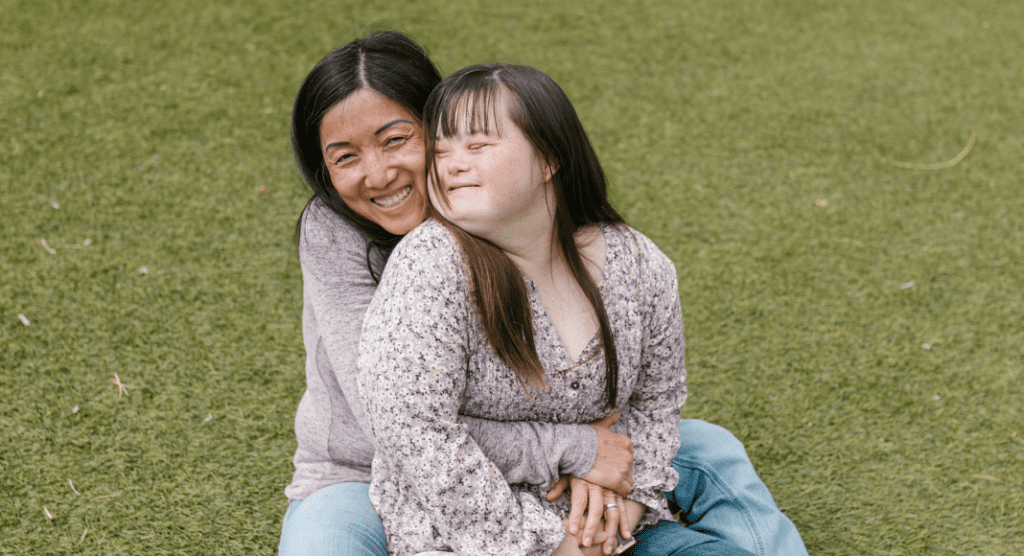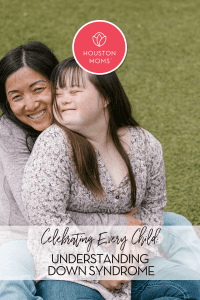I admit at the outset that I decided to write this month about Down Syndrome with a bit of trepidation. I vividly recall the first child with Down Syndrome I met, back when I was still a kid myself. As a middle schooler with a budding love for science, I was nonetheless confused by what exactly the diagnosis met. What I was told then, though, still holds true: children with Down syndrome do have a genetic difference {47 chromosomes rather than the typical 46, with the extra being a third copy of chromosome 21}, but their “extra” often shows up in the form of their bubbly, happy-go-lucky, cheerful personalities.
 The little girl I knew then, a cousin of a family friend, fit this stereotype perfectly – super sweet and kind. Though I imagine she may have encountered some bullying somewhere along the way, I never saw it at our social gatherings, and I don’t think any of us older kids would have stood for it if we had. She endeared herself to everyone.
The little girl I knew then, a cousin of a family friend, fit this stereotype perfectly – super sweet and kind. Though I imagine she may have encountered some bullying somewhere along the way, I never saw it at our social gatherings, and I don’t think any of us older kids would have stood for it if we had. She endeared herself to everyone.
But, fast forward 20+ years and now the main time the topic comes up in my life is in the context of discussing infertility treatment with my patients. When we talk about the wonders of preimplantation genetic testing of embryos during the process of in vitro fertilization {IVF}, and discuss the role of selecting genetically typical embryos {those with 46,XX female or 46,XY male results}, many folks immediately recognize the upshot – “oh, so we can rule out stuff like Down Syndrome, right?”. While the technology was developed to find the majority of genetic differences that would cause an embryo transfer to result in no pregnancy or miscarriage, the question of how to handle results that could lead to a liveborn baby – syndromes like Down or Turner’s – is perhaps more fraught. As is the reality that many women and couples who find themselves with such a diagnosis after they are already pregnant at least consider, if not pursue, pregnancy termination. The diagnosis is one most strongly associated with fear in my professional life – fear of the unknown, fear for a future child’s possible suffering, fear of not having your dreams and wishes for your family come true. I understand that too. So I decided to update my own knowledge on the topic for Down Syndrome Awareness Month, and share my biggest takeaways with you!
What to expect
Kids with Down Syndrome usually only experience mild, sometimes moderate, cognitive issues, like a short attention span or delayed language development. Severe developmental delays are rare. Usually, the slight physical signs associated with Down give the diagnosis away. These include a small head, ears and mouth, eyes with an upward slant, and one deep crease across the palms of the hands, among others. Certain birth defects, like congenital heart disease, are more likely in kids with Down Syndrome, but many children have no other significant health diagnoses. The life expectancy is about 60 years old, rising fast from only 25 years in the 1980s! To the stereotype about happy, cheerful personalities, the data says that the vast majority of those with Down feel happy about their lives, who they are, and how they look.
How common is Down Syndrome?
When it comes to births in the U.S., about 1 in 700 babies born have Down Syndrome, which works out to about 6,000 every year. However, since many pregnancies with this diagnosis are terminated or miscarry, the actual prevalence is quite a bit higher. Though the rate of all chromosomal differences goes up with maternal age, it is still women under 35 who have the most children overall, and they account for 80% of babies with Down Syndrome. To give you a sense of the impact of age, though, the odds go from 1:1,250 at age 25 to 1:378 at age 35 to 1:30 by age 45.
How does Down Syndrome happen?
I’ve alluded to chromosomes and genetics a few times, but to dig down a bit deeper, here are some more details. Human beings have 23 pairs of chromosomes. At the time of egg and sperm meeting, they have started the process of separating the DNA they carry, and so each egg or sperm brings one set. These chromosomes have to find their partner, and complete the process of meiosis {high school biology flashbacks, anyone??}, the embryo thereby getting a full set. Though men continuously make sperm over the course of their lives, women are born with all the eggs we will have. The longer they wait around before being released, the greater the chance that they end up going through this process abnormally, leading to an incorrect number of chromosomes in the embryo {an event called nondisjunction}. This phenomenon accounts for 95% of cases of Down Syndrome.
Resources
From an organizational standpoint, the National Down Syndrome Society is one with some great resources, including this guide to preferred language, i.e. how to talk about Down Syndrome. Perhaps most helpful, they have a map of hundreds of local resources to help folks find support. I would definitely advocate for anyone parenting or considering parenting a child with Down Syndrome to connect with one of these groups to get some insight on everything from navigating schooling to finding supportive physicians and more. On the research side, DS-Connect, sponsored by the National Institutes of Health, is a safe and secure registry to help families and researchers identify similarities and differences in the physical and developmental symptoms and milestones of people with Down syndrome.
In my reading this month, I definitely learned some new facts, even though I’d like to think I know a fair bit about genetics and reproduction! As fertility specialists, we’re always available to talk about this type of topic at length. But of course, many folks may have feelings about Down Syndrome that are driven more by feelings than facts. So that I say what I often say in the office in any variety of circumstances – children thrive when they are loved. Study after study after study has shown that – whether it’s LGBT households, children born from egg or sperm donation, you name it, the data lines up pretty conclusively to show that as long as we do our best to love our kiddos, there’s not as much to fear as we might think.














